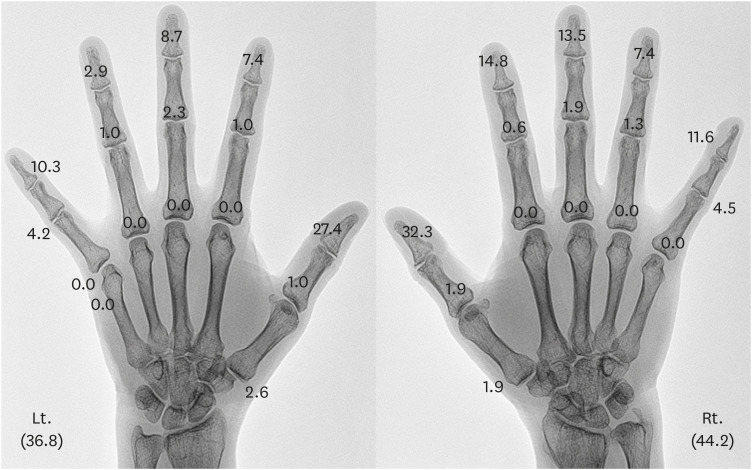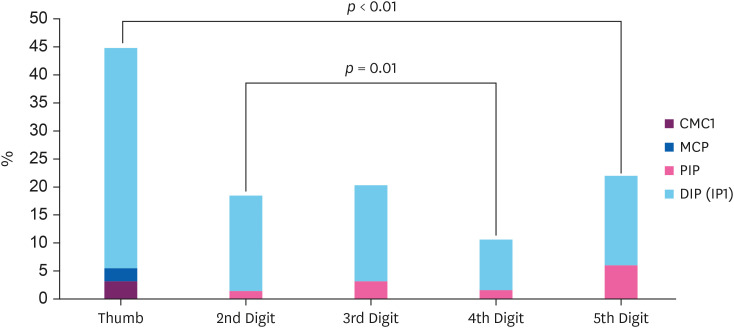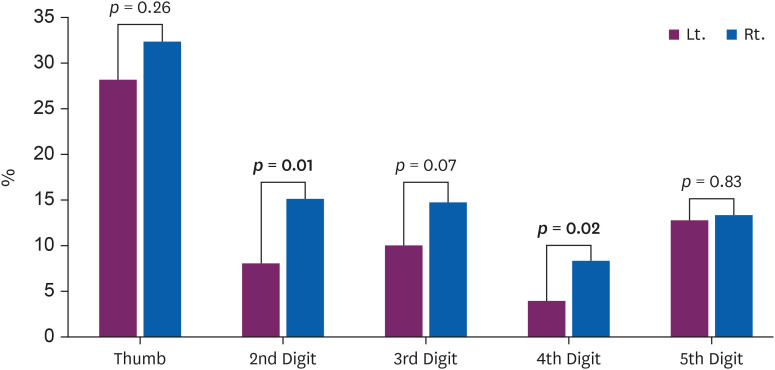Articles
- Page Path
- HOME > Ann Occup Environ Med > Volume 34; 2022 > Article
- Original Article Radiographic hand osteoarthritis in women farmers: characteristics and risk factors
-
Bohyun Sim
 , Jaehoo Lee
, Jaehoo Lee , Chul Gab Lee
, Chul Gab Lee , Hansoo Song
, Hansoo Song
-
Annals of Occupational and Environmental Medicine 2022;34:e10.
DOI: https://doi.org/10.35371/aoem.2022.34.e10
Published online: May 16, 2022
Department of Occupational and Environmental Medicine, Chosun University Hospital, Gwangju, Korea.
- Correspondence: Hansoo Song. Department of Occupational and Environmental Medicine, Chosun University Hospital, 365 Pilmun-daero, Dong-gu, Gwangju 61453, Korea. oemsong@chosun.ac.kr
Copyright © 2022 Korean Society of Occupational & Environmental Medicine
This is an Open Access article distributed under the terms of the Creative Commons Attribution Non-Commercial License (https://creativecommons.org/licenses/by-nc/4.0/) which permits unrestricted non-commercial use, distribution, and reproduction in any medium, provided the original work is properly cited.
Abstract
-
Background Repetitive hand use increases the risk of hand osteoarthritis (OA). This study aimed to investigate characteristics of and risk factors for hand OA in Korean women farmers.
-
Methods This cross-sectional study included women farmers resident in Jeollanam-do, Korea. The participants were interviewed, and radiographs were taken of both hands. Radiological hand OA was defined based on the Osteoarthritis Research Society International imaging criteria of joint space narrowing or the presence of osteophytes. The participants were divided into age groups of < 60 and ≥ 60 years. Obesity was defined as body mass index of > 25 kg/m2. Annual working time was divided into < 2,000, 2,000–2,999, and ≥ 3,000 hours. Agricultural working type was divided into rice farming and field farming. Robust Poisson regression was used to identify factors associated with radiographic hand OA, with adjustment for age, obesity, annual working time, and agricultural classification.
-
Results A total of 310 participants with a mean age of 58.1 ± 7.6 years, were enrolled. The prevalence of radiologically confirmed OA was 49.0%, with an OA prevalence of 39.4% the interphalangeal joint in the thumb (IP1). The prevalence of OA was higher in the distal interphalangeal joint than in the proximal interphalangeal, metacarpophalangeal, and carpometacarpal joints. The prevalence of OA varied by age, annual working time, and agriculture type.
-
Conclusions Korean women farmers have a high prevalence of OA, particularly in the IP1 joints. OA is associated with age, working hours, and agriculture type.
BACKGROUND
METHODS
RESULTS
Participant characteristics, stratified by age (n = 310)
Prevalence (%) of radiographic hand osteoarthritis at the joint level.

Osteoarthritis prevalence by finger of each hand. The p-values were derived with the χ2 test. The IP joint of the thumb is marked together with the DIP joint.

Left and right osteoarthritis patterns at the joint level. The p-values were derived with the χ2 test.

Prevalence of hand OA
Poisson regression with robust standard errors of potential risk factors for OA
DISCUSSION
CONCLUSIONS
Acknowledgements
Abbreviations
APR
BMI
CI
CMC1
DIP
IP1
JSN
Lt.
MCP
OA
PIP
PR
Rt.
SD
-
Funding: This study was supported by research funds from Chosun University Hospital in 2019.
-
Competing interests: The authors declare that they have no competing interests.
-
Authors contributions:
Conceptualization: Song HS.
Data curation: Song HS, Sim BY.
Formal analysis: Song HS.
Funding acquisition: Song HS.
Investigation: Song HS, Lee CG, Sim BY, Lee JH.
Methodology: Song HS, Lee CG.
Software: Sim BH.
Validation: Song HS, Sim BH.
Visualization: Song HS.
Writing - original draft: Sim BH.
Writing - review & editing: Song HS, Lee CG.
NOTES
SUPPLEMENTARY MATERIALS
Supplementary Table 1
Supplementary Table 2
Supplementary Table 3
- 1. Felson DT. The course of osteoarthritis and factors that affect it. Rheum Dis Clin North Am 1993;19(3):607–615. 8210577.ArticlePubMed
- 2. Dahaghin S, Bierma-Zeinstra SM, Ginai AZ, Pols HA, Hazes JM, Koes BW. Prevalence and pattern of radiographic hand osteoarthritis and association with pain and disability (the Rotterdam study). Ann Rheum Dis 2005;64(5):682–687. 15374852.ArticlePubMedPMC
- 3. Damman W, Liu R, Kroon FP, Reijnierse M, Huizinga TW, Rosendaal FR, et al. Do comorbidities play a role in hand osteoarthritis disease burden? data from the hand osteoarthritis in secondary care cohort. J Rheumatol 2017;44(11):1659–1666. 28916548.ArticlePubMed
- 4. Zhang Y, Niu J, Kelly-Hayes M, Chaisson CE, Aliabadi P, Felson DT. Prevalence of symptomatic hand osteoarthritis and its impact on functional status among the elderly: the Framingham Study. Am J Epidemiol 2002;156(11):1021–1027. 12446258.ArticlePubMed
- 5. Kodama R, Muraki S, Oka H, Iidaka T, Teraguchi M, Kagotani R, et al. Prevalence of hand osteoarthritis and its relationship to hand pain and grip strength in Japan: the third survey of the ROAD study. Mod Rheumatol 2016;26(5):767–773. 26882012.ArticlePubMed
- 6. Carmona L, Ballina J, Gabriel R, Laffon A. EPISER Study Group. The burden of musculoskeletal diseases in the general population of Spain: results from a national survey. Ann Rheum Dis 2001;60(11):1040–1045. 11602475.ArticlePubMedPMC
- 7. Kwok WY, Plevier JW, Rosendaal FR, Huizinga TW, Kloppenburg M. Risk factors for progression in hand osteoarthritis: a systematic review. Arthritis Care Res (Hoboken) 2013;65(4):552–562. 22972764.ArticlePubMed
- 8. Denisov LN, Nasonova VA, Koreshkov GG, Kashevarova NG. Role of obesity in the development of osteoarthrosis and concomitant diseases. Ter Arkh 2010;82(10):34–37.
- 9. Cicuttini FM, Baker JR, Spector TD. The association of obesity with osteoarthritis of the hand and knee in women: a twin study. J Rheumatol 1996;23(7):1221–1226. 8823696.PubMed
- 10. Schmid L, Dreier D, Muff B, Allgayer B, Schlumpf U. Lifelong heavy agricultural work and development of arthrosis of the hand--a case study. Z Rheumatol 1999;58(6):345–350. 10663940.PubMed
- 11. Wolf JM, Turkiewicz A, Atroshi I, Englund M. Occupational load as a risk factor for clinically relevant base of thumb osteoarthritis. Occup Environ Med 2020;77(3):168–171. 31959639.ArticlePubMed
- 12. Kang HJ. An analysis of factors affecting economic activities of the Korean women farmers. J Rural Dev 2008;31(4):69–81.
- 13. Dahaghin S, Bierma-Zeinstra SM, Reijman M, Pols HA, Hazes JM, Koes BW. Does hand osteoarthritis predict future hip or knee osteoarthritis? Arthritis Rheum 2005;52(11):3520–3527. 16255023.ArticlePubMed
- 14. Niu J, Zhang Y, LaValley M, Chaisson CE, Aliabadi P, Felson DT. Symmetry and clustering of symptomatic hand osteoarthritis in elderly men and women: the Framingham Study. Rheumatology (Oxford) 2003;42(2):343–348. 12595633.ArticlePubMed
- 15. van Saase JL, van Romunde LK, Cats A, Vandenbroucke JP, Valkenburg HA. Epidemiology of osteoarthritis: Zoetermeer survey. Comparison of radiological osteoarthritis in a Dutch population with that in 10 other populations. Ann Rheum Dis 1989;48(4):271–280. 2712610.ArticlePubMedPMC
- 16. Kalichman L, Li L, Batsevich V, Kobyliansky E. Hand osteoarthritis in the Abkhazian population. Homo 2009;60(5):429–439. 19733350.ArticlePubMed
- 17. Caspi D, Flusser G, Farber I, Ribak J, Leibovitz A, Habot B, et al. Clinical, radiologic, demographic, and occupational aspects of hand osteoarthritis in the elderly. Semin Arthritis Rheum 2001;30(5):321–331. 11303305.ArticlePubMed
- 18. Nakamura M, Murakami G, Isogai S, Ishizawa M. Regional specificity in degenerative changes in finger joints: an anatomical study using cadavers of the elderly. J Orthop Sci 2001;6(5):403–413. 11845349.ArticlePubMed
- 19. Busby J, Tobin J, Ettinger W, Roadarmel K, Plato CC. A longitudinal study of osteoarthritis of the hand: the effect of age. Ann Hum Biol 1991;18(5):417–424. 1952799.ArticlePubMed
- 20. Kalichman L, Cohen Z, Kobyliansky E, Livshits G. Patterns of joint distribution in hand osteoarthritis: contribution of age, sex, and handedness. Am J Hum Biol 2004;16(2):125–134. 14994312.ArticlePubMed
- 21. Marshall M, van der Windt D, Nicholls E, Myers H, Hay E, Dziedzic K. Radiographic hand osteoarthritis: patterns and associations with hand pain and function in a community-dwelling sample. Osteoarthritis Cartilage 2009;17(11):1440–1447. 19500560.ArticlePubMed
- 22. Kim KR, Lee KS, Kim HC, Ko ES, Song EY. Health condition and musculoskeletal disorders (MSDs) in fruit-growers. Korean J Community Living Sci 2009;20(1):5–17.
- 23. Hong CY, Lee CG, Kim DH, Cho YS, Kim KY, Ryu SY, et al. Work-related risk factors of knee meniscal tears in Korean farmers: a cross-sectional study. Saf Health Work 2020;11(4):485–490. 33329915.ArticlePubMedPMC
- 24. Do S, Lee CG, Kim DH, Lee G, Kim KY, Ryu SY, et al. Factors related to femoral bowing among Korean female farmers: a cross-sectional study. Ann Occup Environ Med 2020;32(1):e23. 32802339.ArticlePubMedPMCPDF
- 25. Hong C, Lee CG, Song H. Characteristics of lumbar disc degeneration and risk factors for collapsed lumbar disc in Korean farmers and fishers. Ann Occup Environ Med 2021;33:e16. 34754477.ArticlePubMedPMCPDF
- 26. Hong JH, Han MS, Lee SK, Lee JK, Moon BJ. Is the agricultural work a risk factor for Koreans elderly spinal sagittal imbalance? J Korean Neurosurg Soc 2020;63(5):623–630. 32759626.ArticlePubMedPMCPDF
- 27. Cho NH, Jung YO, Lim SH, Chung CK, Kim HA. The prevalence and risk factors of low back pain in rural community residents of Korea. Spine (Phila Pa 1976) 2012;37(24):2001–2010. 22588379.ArticlePubMed
- 28. Aletaha D, Neogi T, Silman AJ, Funovits J, Felson DT, Bingham CO 3rd, et al. 2010 Rheumatoid arthritis classification criteria: an American College of Rheumatology/European League Against Rheumatism collaborative initiative. Arthritis Rheum 2010;62(9):2569–2581. 20872595.PubMed
- 29. Altman RD, Gold GE. Atlas of individual radiographic features in osteoarthritis, revised. Osteoarthritis Cartilage 2007;15(Suppl A):A1–56. 17320422.ArticlePubMed
- 30. Paradowski PT, Lohmander LS, Englund M. Natural history of radiographic features of hand osteoarthritis over 10 years. Osteoarthritis Cartilage 2010;18(7):917–922. 20417289.ArticlePubMed
- 31. Haugen IK, Englund M, Aliabadi P, Niu J, Clancy M, Kvien TK, et al. Prevalence, incidence and progression of hand osteoarthritis in the general population: the Framingham Osteoarthritis Study. Ann Rheum Dis 2011;70(9):1581–1586. 21622766.ArticlePubMedPMC
- 32. Kim M, Yoo JI, Kim MJ, Na JB, Lee SI, Park KS. Prevalence of upper extremity musculoskeletal diseases and disability among fruit tree farmers in Korea: cross-sectional study. Yonsei Med J 2019;60(9):870–875. 31433585.ArticlePubMedPMCPDF
- 33. Cooney WP 3rd, Chao EY. Biomechanical analysis of static forces in the thumb during hand function. J Bone Joint Surg Am 1977;59(1):27–36. 833171.ArticlePubMed
- 34. Jung HS, Jung HS. Hand dominance and hand use behaviour reported in a survey of 2437 Koreans. Ergonomics 2009;52(11):1362–1371. 19851904.ArticlePubMed
- 35. Kalichman L, Hernández-Molina G. Hand osteoarthritis: an epidemiological perspective. Semin Arthritis Rheum 2010;39(6):465–476. 19482338.ArticlePubMed
- 36. Wilder FV, Barrett JP, Farina EJ. Joint-specific prevalence of osteoarthritis of the hand. Osteoarthritis Cartilage 2006;14(9):953–957. 16759885.ArticlePubMed
- 37. Kaufmann RA, Lögters TT, Verbruggen G, Windolf J, Goitz RJ. Osteoarthritis of the distal interphalangeal joint. J Hand Surg Am 2010;35(12):2117–2125. 21134619.ArticlePubMed
- 38. Goislard de Monsabert B, Vigouroux L, Bendahan D, Berton E. Quantification of finger joint loadings using musculoskeletal modelling clarifies mechanical risk factors of hand osteoarthritis. Med Eng Phys 2014;36(2):177–184. 24210852.ArticlePubMed
- 39. Tan AL, Grainger AJ, Tanner SF, Shelley DM, Pease C, Emery P, et al. High-resolution magnetic resonance imaging for the assessment of hand osteoarthritis. Arthritis Rheum 2005;52(8):2355–2365. 16052535.PubMed
- 40. Yusuf E, Nelissen RG, Ioan-Facsinay A, Stojanovic-Susulic V, DeGroot J, van Osch G, et al. Association between weight or body mass index and hand osteoarthritis: a systematic review. Ann Rheum Dis 2010;69(4):761–765. 19487215.ArticlePubMed
- 41. Kim W, Han JW. Productivity improvement by mechanization of field farming. Food Ind Nutr 2016;21(2):29–31.
REFERENCES
REFERENCES
Figure & Data
REFERENCES
Citations

- Hand Osteoarthritis in Elderly Women with Primary Knee Osteoarthritis: Prevalence and Pattern in the Indian Population
Pooja Dhaon, Astha Singh, Kushal Singh, Siddharth Tiwari, Haseeb Khan
Indian Journal of Rheumatology.2025; 20(2): 130. CrossRef - Effects of regional variations and occupation on hand osteoarthritis: Insights from the research on osteoarthritis/osteoporosis against disability study
Ichiko Kojima, Kosuke Uehara, Toshiko Iidaka, Rie Kodama, Shigeyuki Muraki, Hiroyuki Oka, Hiroshi Kawaguchi, Toru Akune, Hiroshi Hashizume, Hiroshi Yamada, Munehito Yoshida, Yutaka Morizaki, Kozo Nakamura, Sakae Tanaka, Noriko Yoshimura
Modern Rheumatology.2025; 35(4): 777. CrossRef - Diagnostic accuracy of history taking, physical examination, and auxiliary examination for thumb osteoarthritis: a systematic review
Yisha He, Patrick Krastman, Sita M. A. Bierma-Zeinstra, Gerald Kraan, Nina M. Mathijssen, Jos Runhaar
Annals of Medicine.2025;[Epub] CrossRef - What is the most important mechanical factor involved in trapeziometacarpal osteoarthritis development? A sensitivity analysis based on biomechanical modelling
Thomas Valerio, Jean-Louis Milan, Benjamin Goislard de Monsabert, Laurent Vigouroux
Computer Methods in Biomechanics and Biomedical Engineering.2024; : 1. CrossRef - Identification of susceptibility modules and hub genes of osteoarthritis by WGCNA analysis
Yanchao Wang, Wenjun Zhou, Yan Chen, Dong He, Zhen Qin, Zhao Wang, Song Liu, Lei Zhou, Jianwen Su, Chi Zhang
Frontiers in Genetics.2022;[Epub] CrossRef



Fig. 1
Fig. 2
Fig. 3
| Variable | < 60 years (n = 176) | ≥ 60 years (n = 134) | Total (n = 310) | ||
|---|---|---|---|---|---|
| BMI (kg/m2) | 0.456 | ||||
| < 25 | 91 (51.7) | 75 (56.0) | 166 (53.5) | ||
| ≥ 25 | 85 (48.3) | 59 (44.0) | 144 (46.5) | ||
| Mean ± SD | 25.3 ± 3.4 | 25.1 ± 3.0 | 25.2 ± 3.3 | 0.564a | |
| Annual working time (hour/year) | 0.110 | ||||
| < 2,000 | 78 (44.3) | 60 (44.8) | 138 (44.5) | ||
| 2,000–2,999 | 52 (29.5) | 51 (38.1) | 103 (33.2) | ||
| ≥ 3,000 | 46 (26.1) | 23 (17.2) | 69 (22.3) | ||
| Mean ± SD | 2,295.9 ± 1,158.6 | 2,154.3 ± 953.1 | 2,234.7 ± 1,075.2 | 0.239a | |
| Agricultural classification | 0.468 | ||||
| Rice farming | 94 (53.1) | 66 (49.3) | 160 (51.6) | ||
| Field farming | 82 (46.6) | 68 (50.7) | 150 (48.4) | ||
| Variables | Hand OA | IP1 OA | |||
|---|---|---|---|---|---|
| % | % | ||||
| Age (years) | < 0.001 | < 0.001 | |||
| < 60 | 34.7 | 27.3 | |||
| ≥ 60 | 67.9 | 55.2 | |||
| BMI (kg/m2) | 0.317 | 0.214 | |||
| < 25 | 46.4 | 36.1 | |||
| ≥ 25 | 52.1 | 43.1 | |||
| Annual working time (hour/year) | 0.015a | 0.025a | |||
| < 2,000 | 41.3 | 31.2 | |||
| 2,000–2,999 | 53.4 | 46.6 | |||
| ≥ 3,000 | 58.0 | 44.9 | |||
| Agricultural classification | 0.005 | < 0.001 | |||
| Rice farming | 41.3 | 30.0 | |||
| Field farming | 57.3 | 49.3 | |||
| Total | 49.0 | 39.4 | |||
| Variables | Hand OA | IP1 OA | |||||||
|---|---|---|---|---|---|---|---|---|---|
| Crude | Adjusted | Crude | Adjusted | ||||||
| PR | 95% CI | PR | 95% CI | PR | 95% CI | PR | 95% CI | ||
| Age (years) | |||||||||
| < 60 | 1.00 | 1.00 | 1.00 | 1.00 | |||||
| ≥ 60 | 1.96 | 1.55–2.48 | 2.01 | 1.60–2.53 | 2.02 | 1.52–2.69 | 2.06 | 1.55–2.72 | |
| BMI (kg/m2) | |||||||||
| < 25 | 1.00 | 1.00 | 1.00 | 1.00 | |||||
| ≥ 25 | 1.12 | 0.90–1.41 | 1.18 | 0.95–1.45 | 1.19 | 0.90–1.57 | 1.25 | 0.96–1.61 | |
| Annual working time (hours/year) | |||||||||
| < 2,000 | 1.00 | 1.00 | 1.00 | 1.00 | |||||
| 2,000–2,999 | 1.29 | 0.99–1.69 | 1.20 | 0.94–1.55 | 1.50 | 1.08–2.07 | 1.37 | 1.01–1.85 | |
| ≥ 3,000 | 1.40 | 1.06–1.86 | 1.49 | 1.14–1.94 | 1.44 | 1.01–2.07 | 1.52 | 1.08–2.14 | |
| Agricultural classification | |||||||||
| Rice farming | 1.00 | 1.00 | 1.00 | 1.00 | |||||
| Field farming | 1.64 | 1.23–2.19 | 1.31 | 1.05–1.63 | 1.39 | 1.10–1.75 | 1.53 | 1.16–2.01 | |
Values are presented as number (%). The
BMI: Body mass index; SD: standard deviation.
aThe
The
OA: osteoarthritis; IP1: interphalangeal joint in the thumb; BMI: body mass index.
aThe
Adjusted prevalence ratio; age, BMI, annual working time, agricultural classification.
OA: osteoarthritis; CI: confidence interval; IP1: interphalangeal joint in the thumb; BMI: body mass index; PR: prevalence ratio.
 KSOEM
KSOEM

 Cite
Cite

